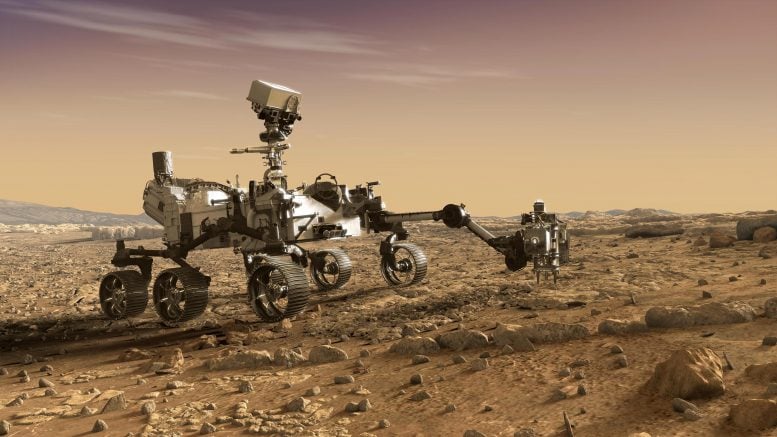
By studying the leopard-like spots on rocks from Earth and Mars now, scientists will be ready to analyze returned space samples when they arrive.
In 2024, NASA’s Perseverance rover retrieved an unusual rock sample from Mars. Named Sapphire Canyon, the specimen stands out for its striking pattern: pale, leopard-like spots with dark outlines set against a reddish mudstone. Scientists believe it could offer valuable clues about potential sources of organic molecules on the planet.
On Earth, researchers from NASA’s Jet Propulsion Laboratory and the California Institute of Technology reported in Review of Scientific Instruments that they analyzed a rock with a similar appearance. Their goal was to explore whether a technique called optical photothermal infrared spectroscopy (O-PTIR) could be used to study the Sapphire Canyon sample once it is eventually returned to Earth.
O-PTIR works by directing two lasers at a material. The first laser gently heats the surface, creating subtle thermal vibrations that vary with the light’s wavelength. The second laser then measures these changes. Combined, these measurements reveal the material’s distinct chemical fingerprint.
From Arizona to the Lab
The researchers tested O-PTIR on a basalt rock with dark inclusions of similar size to the Sapphire Canyon sample’s, which, in contrast to Perseverance’s sophisticated sample selection process, author Nicholas Heinz found purely by coincidence.
“I was hiking in Arizona, in Sedona, when I saw this rock that just didn’t look like it belonged,” he said. “I put it in my backpack and brought it back to look at.”

They aimed to see if O-PTIR could differentiate between the rock’s primary material and its dark inclusions and found it was extremely effective because of the enhanced spatial resolution of O-PTIR. Moreover, O-PTIR is a rapid technique. Each spectrum can be collected in minutes, allowing scientists to go in with a more sensitive technique to study potential areas of interest identified in more detail, such as regions containing organics.
“I hope this capability will be considered for any future material returned from Mars, an asteroid, or any other planetary surface,” said Heinz.
The team’s O-PTIR capabilities are the only of their kind available at NASA’s Jet Propulsion Laboratory and have already been used by other NASA missions — in 2024, they helped confirm the cleanliness of Europa Clipper, a mission to study one of Jupiter’s moons, prior to its launch. Heinz said that now that they’ve shown its additional benefits in applications related to Mars samples, and geology more widely, they are working with NASA’s Mars science team to test the algal microfossils typically used as Mars analogs for the rovers.
Reference: “Application of optical photothermal infrared spectroscopy (O-PTIR) for future returned Mars samples” by Nicholas Heinz, Mark S. Anderson, Jerami Mennella and George R. Rossman, 12 August 2025, Review of Scientific Instruments.
DOI: 10.1063/5.0266350
Never miss a breakthrough: Join the SciTechDaily newsletter.